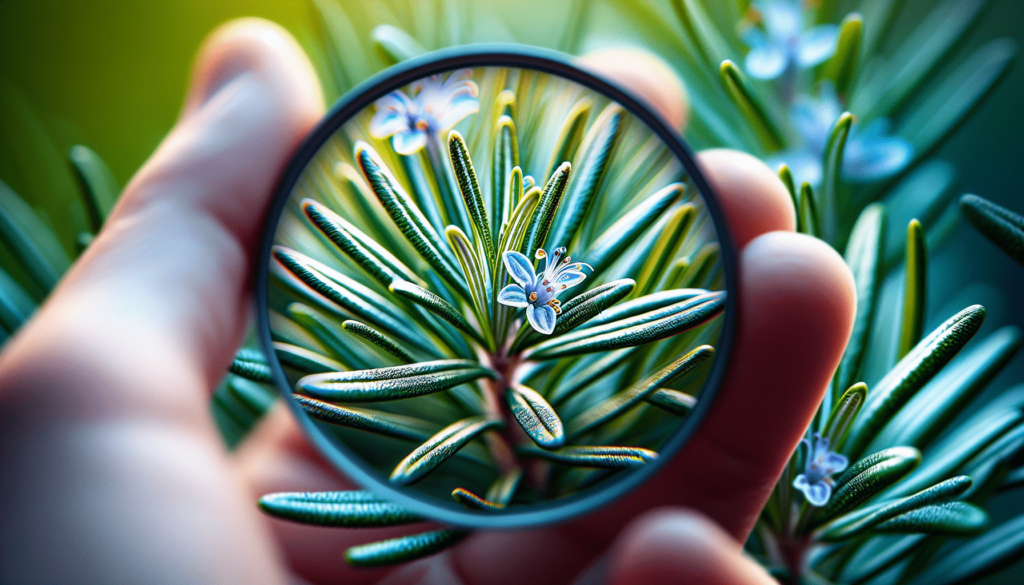Whether you’re a seasoned gardener or just starting out, having a collection of perennial herbs in your garden is a wonderful addition. These hardy plants not only provide a fresh supply of aromatic and flavorful herbs, but they also come back year after year, saving you time and effort. In this article, we will explore ten perennial herbs that are perfect for your garden, offering a range of tastes and textures to enhance your culinary creations. So, roll up your sleeves and get ready to discover nature’s gift that keeps on giving!
1. Rosemary
Overview of Rosemary
Rosemary is a versatile and aromatic perennial herb that is a must-have addition to any herb garden. With its distinct pine-like fragrance and needle-like leaves, it adds both flavor and fragrance to your culinary endeavors. Rosemary belongs to the mint family and is native to the Mediterranean region. It has been used for centuries in cooking, medicine, and even as an ornamental plant. Its woody stems and small blue flowers make it not only a useful herb but also a visually appealing addition to any garden.
Growing Rosemary in Your Garden
If you’re considering growing rosemary in your garden, you’re in luck! Rosemary is relatively easy to grow and requires minimal maintenance. It thrives in warm and sunny conditions, ideally in a location that receives at least six hours of direct sunlight each day. Rosemary prefers well-drained soil, so make sure to plant it in a spot with good drainage or mix some sand or gravel into the soil. You can either grow rosemary from seeds or propagate it from cuttings. However, keep in mind that rosemary seeds can be slow to germinate, so starting with cuttings might be a better option if you’re eager to see results quickly.
Caring for Rosemary Plants
Once your rosemary plants are established, caring for them is relatively simple. Watering rosemary can be a bit tricky since it doesn’t like wet feet. It’s important to strike the right balance between not letting the soil dry out completely and not overwatering. Allow the top inch of soil to dry out before watering again, and make sure the pot or the ground provides proper drainage. Applying a layer of mulch around the base of the plant can help retain moisture and suppress weed growth. Pruning your rosemary plant regularly will not only keep it tidy and compact but also promote healthy growth. In colder climates, consider bringing potted rosemary indoors during the winter to protect it from freezing temperatures.
Harvesting and Using Rosemary
One of the most rewarding aspects of growing rosemary is being able to harvest and use it in your culinary creations. Rosemary leaves are packed with flavor, and they can be harvested throughout the year. Simply snip off sprigs as needed, making sure not to remove more than a third of the plant’s foliage at once. The leaves can be used fresh or dried for later use. Rosemary pairs well with roasted meats, potatoes, stews, and even bread. You can infuse its flavor into oils, vinegars, or even cocktails. The possibilities are endless, so get creative and add a sprig or two of rosemary to elevate the taste of your dishes.
2. Thyme
Overview of Thyme
Thyme is a perennial herb known for its aromatic and earthy flavor. It belongs to the mint family and is native to the Mediterranean region. Thyme has a long history of medicinal, culinary, and ornamental use. Its small, narrow leaves are rich in essential oils, which give it its distinct fragrance and taste. Thyme comes in various varieties, including common thyme, lemon thyme, and creeping thyme. Each variety has its unique characteristics, but they all share the same resilience and versatility.
Growing Thyme in Your Garden
Growing thyme in your garden is a great way to enjoy this flavorful herb throughout the year. Thyme thrives in well-drained soil and prefers full sun. It can tolerate a wide range of soil conditions, making it a versatile herb that can adapt to different growing environments. Whether you’re adding thyme to your herb garden, a container, or a rock garden, it will flourish as long as it gets at least six hours of sunlight each day. Thyme can be propagated through seeds or cuttings, but starting with young plants from a nursery is often more convenient and time-saving.
Caring for Thyme Plants
Taking care of thyme plants is relatively low-maintenance. Thyme doesn’t require excessive watering and is fairly drought-tolerant once established. It’s best to allow the soil to dry out slightly in between waterings. Overwatering can lead to root rot and other issues. Prune your thyme plants regularly to maintain their shape and prevent them from becoming overly woody. Thyme is known to attract beneficial pollinators like bees, butterflies, and hummingbirds, so let your thyme plants flower to encourage biodiversity in your garden.
Harvesting and Using Thyme
When it comes to harvesting thyme, the leaves can be collected throughout the growing season, but the flavor is most concentrated right before the plants bloom. Simply snip off the top four to six inches of the stems, collecting the leaves as you go. Thyme leaves can be used fresh or dried for long-term storage. Thyme is an essential herb in Mediterranean cuisine and pairs well with roasted vegetables, grilled meats, soups, and sauces. Its flavor also complements cheeses and is often used in herbal teas and infused oils. Add a sprinkle of thyme to your favorite dishes and elevate their taste with its delightful flavor.
3. Sage
Overview of Sage
Sage is a beloved perennial herb that is both flavorful and visually appealing. With its velvety gray-green leaves and delicate purple flowers, sage adds a touch of elegance to any garden. Sage belongs to the mint family and is native to the Mediterranean region. It has a long history of culinary and medicinal uses and is often associated with holiday dishes and stuffings. Sage leaves have a warm, slightly minty flavor with hints of earthiness and spice, making them a versatile ingredient in various cuisines.
Growing Sage in Your Garden
Growing sage in your garden is a rewarding experience, as this herb is relatively easy to cultivate. Sage thrives in well-drained soil and prefers full sun. It can tolerate a wide range of soil conditions, but it’s important to avoid heavy, waterlogged soils that can cause root rot. Planting sage in raised beds or containers with good drainage can help ensure its optimal growth. You can start sage from seeds, but it’s often more convenient to purchase young plants from a nursery and transplant them into your garden.
Caring for Sage Plants
Caring for sage plants is relatively low-maintenance, making it a suitable choice for gardeners of all skill levels. Sage doesn’t require excessive watering and can withstand periods of drought. It’s best to allow the soil to dry out between waterings to prevent root rot. Pruning sage regularly is beneficial to keep the plant compact and promote new growth. Sage is a perennial herb, so ensure it is protected from harsh winter conditions if you live in a colder climate. Applying a layer of mulch around the base of the plant can help insulate the roots during winter.
Harvesting and Using Sage
Harvesting sage can be done throughout the growing season, but it’s best to wait until the plant is established and has enough foliage for sustainable growth. When harvesting, snip off individual leaves or small sprigs from the plant. Keep in mind that sage has a strong flavor, so a little goes a long way. Sage leaves can be used fresh or dried for long-term storage. They are a popular addition to stuffing, poultry dishes, roasted vegetables, and sauces. Sage pairs well with meats like pork and lamb and can even be used to infuse butter or vinegar for an extra kick of flavor. Experiment with sage in your recipes and savor its unique taste.
4. Mint
Overview of Mint
Mint is a refreshing and aromatic perennial herb that adds a burst of flavor to both sweet and savory dishes. With its bright green leaves and distinctive scent, mint is a popular choice for many culinary applications. Mint belongs to the mint family and is known for its vigorous growth. It spreads rapidly through underground stems, so planting it in containers or using barriers can help control its spread in the garden. Mint comes in different varieties, including spearmint, peppermint, and chocolate mint, each with its unique taste and fragrance.
Growing Mint in Your Garden
Growing mint in your garden can be an enjoyable and rewarding experience. Mint thrives in moist soil and prefers partial shade to full sun. While it can tolerate a range of soil types, ensuring good drainage is essential to prevent root rot. A great way to incorporate mint into your garden is to plant it in containers or pots, which will contain its growth and prevent it from overtaking other plants. Starting mint from young plants or cuttings is easier and more reliable than growing it from seeds.
Caring for Mint Plants
Taking care of mint plants is relatively easy, but it’s important to stay on top of their growth to prevent overcrowding. Mint requires regular watering to keep the soil evenly moist, especially during hot summer months. Mulching around the base of the plants can help retain soil moisture and suppress weed growth. Pruning or harvesting the top third of the mint plant regularly will encourage bushier growth and prevent it from becoming leggy. Mint is a hardy herb, but it can be susceptible to pests like aphids or spider mites. Inspect your plants regularly for any signs of infestation and take appropriate measures if necessary.
Harvesting and Using Mint
When it comes to harvesting mint, the leaves can be collected as soon as the plant has sufficient foliage for sustainable growth. Gently pluck individual leaves or trim entire stems from the plant, leaving about two inches of growth to encourage regrowth. Mint leaves can be used fresh or dried for later use. Mint is a versatile herb that adds a refreshing note to beverages, salads, desserts, and even savory dishes like lamb or pea soups. It can also be used to make flavored oils, teas, or infused water. Get creative with mint and let its invigorating flavor take your recipes to new heights.
5. Oregano
Overview of Oregano
Oregano is a flavorful and aromatic perennial herb that is a staple in Mediterranean and Mexican cuisines. With its pungent leaves and small purple flowers, oregano adds depth and complexity to a wide range of dishes. Oregano belongs to the mint family and is native to the Mediterranean region. There are several varieties of oregano, including Greek oregano, Italian oregano, and Mexican oregano, each with its distinct flavor profile.
Growing Oregano in Your Garden
Growing oregano in your garden is a great way to infuse your dishes with its signature taste. Oregano thrives in well-drained soil and prefers full sun. It can tolerate various soil types, but adding organic matter like compost can improve its overall health and productivity. Oregano can be sown from seeds or propagated through cuttings. Starting with young plants from a nursery is often a faster and more reliable option. Whether you’re planting it in garden beds, containers, or even interplanting it with other herbs and vegetables, oregano is a versatile herb that adapts well to different gardening environments.
Caring for Oregano Plants
Caring for oregano plants is relatively simple, making it an ideal herb for beginner gardeners. Oregano doesn’t require excessive watering and is fairly drought-tolerant once established. It’s best to water oregano when the top inch of the soil feels dry. Overwatering can lead to root rot and other issues. Pruning oregano regularly will promote bushier growth and help prevent it from becoming overly leggy. Oregano is a hardy herb that can withstand cold temperatures, but it may require some protection in extremely harsh winter conditions.
Harvesting and Using Oregano
Harvesting oregano can be done throughout the growing season, but the flavor is most concentrated just before the plant flowers. When harvesting, trim the stems from the plant, leaving two to four inches of growth to encourage regrowth. Oregano leaves can be used fresh or dried for long-term storage. Oregano is an essential herb in Italian and Greek cuisines and pairs well with tomatoes, grilled meats, roasted vegetables, and pasta dishes. It’s also a popular addition to herb blends, marinades, salad dressings, and even homemade pizza sauces. Add a sprinkle of oregano to your favorite recipes and let its aromatic flavor transport your taste buds.
6. Lemon Balm
Overview of Lemon Balm
Lemon balm is a delightful perennial herb known for its citrusy fragrance and calming properties. With its vibrant green leaves and small white flowers, lemon balm adds beauty and serenity to any garden. Lemon balm belongs to the mint family and is native to the Mediterranean region. It has a long history of culinary and medicinal use, often being praised for its soothing and stress-relieving effects. The leaves of lemon balm have a refreshing lemony aroma and a mild, slightly sweet taste.
Growing Lemon Balm in Your Garden
Growing lemon balm in your garden is a wise choice, as it’s not only a versatile herb but also an attractive addition to any landscape. Lemon balm thrives in well-drained soil and can tolerate a range of soil conditions. It prefers partial shade but can also handle full sun as long as it receives sufficient water. Planting lemon balm in containers is a practical way to control its growth, as it has a tendency to spread rapidly. Starting with young plants from a nursery is a convenient option if you’re looking for quick results.
Caring for Lemon Balm Plants
Taking care of lemon balm plants is relatively easy, and they require minimal maintenance. Lemon balm enjoys consistently moist soil, so regular watering is essential, particularly during hot summer months. Applying a layer of mulch around the base of the plant can help retain soil moisture and suppress weed growth. Pruning lemon balm regularly will keep the plant tidy and prevent it from becoming overly leggy. Lemon balm is generally pest-resistant, but keep an eye out for any signs of aphids or other common garden pests, and take appropriate measures if necessary.
Harvesting and Using Lemon Balm
When it’s time to harvest lemon balm, simply snip off individual leaves or cut entire stems from the plant. The leaves can be used fresh or dried for later use. Lemon balm is a versatile herb that can be used in both sweet and savory dishes. Its refreshing lemon flavor pairs well with fruits, salads, herbal teas, and even cocktails. Lemon balm leaves can also be infused in oil or vinegar and used to flavor homemade lotions, soaps, or DIY insect repellents. Embrace the soothing qualities of lemon balm and let its aroma transport you to a state of tranquility.
7. Chives
Overview of Chives
Chives are a popular perennial herb known for their mild onion flavor and delicate purple flowers. With their slender, hollow leaves, chives bring a touch of elegance and freshness to any garden. Chives belong to the onion family and are native to Europe, Asia, and North America. They have been used in culinary and medicinal practices for centuries. Chives are an essential ingredient in many dishes, particularly in classic French cuisine.
Growing Chives in Your Garden
Growing chives in your garden is a great way to add a burst of flavor to your dishes throughout the year. Chives are low-maintenance and can thrive in almost any garden. They prefer well-drained soil and full sun but can tolerate partial shade. Whether you’re planting them in garden beds or containers, chives are a versatile herb that adapts well to different growing conditions. You can start chives from seeds, but it’s often more convenient to purchase young plants from a nursery and transplant them into your garden.
Caring for Chives Plants
Taking care of chives plants is relatively easy, and they require minimal attention. Chives don’t require excessive watering and prefer slightly moist soil. It’s best to let the soil dry out slightly between waterings. Prune your chives regularly to encourage healthy growth and prevent them from becoming too leggy. Chives are generally resistant to pests and diseases, making them a low-maintenance option in the garden. If you experience extremely harsh winter conditions, consider mulching around the base of the plants to protect them from freezing temperatures.
Harvesting and Using Chives
When it’s time to harvest chives, you can simply snip off the leaves from the plant as needed. Chives can be used fresh or dried for later use, but their flavor is most potent when used fresh. Chopped chives can be sprinkled over salads, soups, omelets, baked potatoes, and so much more. They add a subtle onion flavor and a vibrant touch of green to any dish. Chives also make a wonderful addition to compound butters, marinades, and herb blends. Enjoy the versatility of chives in your culinary creations and savor their delicate onion essence.
8. Lavender
Overview of Lavender
Lavender is a fragrant and visually appealing perennial herb that brings a sense of calm and tranquility to any garden. With its slender silver-green foliage and vibrant purple flowers, lavender adds a touch of elegance and beauty to the landscape. Lavender belongs to the mint family and is native to the Mediterranean region. It has long been cherished for its soothing scent and has a variety of culinary, medicinal, and ornamental uses. Lavender flowers are rich in essential oils, giving them their distinct fragrance and flavor.
Growing Lavender in Your Garden
Growing lavender in your garden can be a delightful and rewarding experience. Lavender thrives in well-drained soil and requires full sun to bloom abundantly. It prefers alkaline soil with a pH level between 6.5 and 8. Lavender can tolerate dry and arid conditions, making it an excellent choice for water-wise gardens. Planting lavender in raised beds or containers with good drainage can help ensure its optimal growth. You can start lavender from seeds, but it’s often more convenient and reliable to purchase young plants from a nursery.
Caring for Lavender Plants
Caring for lavender plants is relatively low-maintenance, but they do require some attention to thrive. Lavender doesn’t require frequent watering and prefers dry or slightly moist soil. It’s best to water lavender deeply but infrequently to encourage deep root growth. Prune lavender plants regularly to maintain their shape and promote new growth. It’s important to prune lavender in the spring, just as new growth begins, to prevent the plant from becoming woody and leggy. Lavender is generally pest-resistant, but keep an eye out for any signs of aphids or other common garden pests, and take appropriate measures if necessary.
Harvesting and Using Lavender
Harvesting lavender can be done when the flowers have fully bloomed and just before they start to fade. Snip the flower stems just above the leaves, leaving some foliage for the plant to continue growing. Lavender flowers can be used fresh or dried for later use. They are a popular addition to teas, syrups, desserts, and even savory dishes. Lavender can also be used to infuse honey, oils, and bath products, adding a touch of relaxation to your daily routine. Explore the various ways to use lavender and let its enchanting aroma transport you to a state of serenity.
9. Parsley
Overview of Parsley
Parsley is a versatile and nutritious perennial herb that is frequently used as a garnish and flavor enhancer in various cuisines worldwide. With its vibrant green curly or flat leaves and mild flavor, parsley is a must-have herb in any kitchen garden. Parsley belongs to the carrot family and is native to the Mediterranean region. It has been cultivated for centuries for both its culinary and medicinal properties. Parsley leaves are rich in vitamins A, C, and K, as well as iron and folate.
Growing Parsley in Your Garden
Growing parsley in your garden is a wonderful way to add freshness and a pop of color to your culinary creations. Parsley prefers well-drained soil and partial shade to full sun. It can tolerate a wide range of soil conditions but thrives in moist, rich soil. Starting parsley from seeds is typically the most cost-effective option, as the seeds germinate relatively easily. Sow the seeds directly in the garden or start them indoors before transplanting. Engaging in regular succession planting will ensure a continuous supply of fresh parsley throughout the growing season.
Caring for Parsley Plants
Caring for parsley plants is relatively straightforward, and they don’t require excessive attention. Parsley prefers consistently moist soil, so regular watering is essential. However, be careful not to overwater, as this can lead to root rot and other issues. Applying a layer of mulch around the base of the plants can help retain soil moisture and suppress weed growth. Pruning the outer leaves regularly will encourage new growth and prevent the plants from becoming woody. Parsley is generally resistant to pests, but keep an eye out for signs of aphids or caterpillars and take appropriate measures if necessary.
Harvesting and Using Parsley
When it comes to harvesting parsley, you can begin snipping off outer leaves as soon as the plants have enough foliage for sustainable growth. Harvesting parsley from the outermost sections will allow the inner leaves to continue growing. Parsley leaves can be used fresh or dried for later use. Add finely chopped parsley to salads, pasta dishes, soups, and sauces for a burst of freshness and color. It also pairs well with fish, meat, and vegetable dishes. The flavor of parsley leaves intensifies when dried, so keep this in mind when considering the amount to use in your recipes. Embrace the versatility of parsley and let it be the finishing touch to your culinary masterpieces.
10. Marjoram
Overview of Marjoram
Marjoram is a delicate and aromatic perennial herb that adds a subtle, slightly sweet flavor to a variety of dishes. With its small gray-green leaves and compact growth habit, marjoram is a charming addition to any herb garden. Marjoram belongs to the mint family and is native to the Mediterranean region. It has a long history of culinary and medicinal uses, often being used as a substitute for its close relative, oregano. Marjoram leaves have a mild and floral taste, making them a versatile herb in the kitchen.
Growing Marjoram in Your Garden
Growing marjoram in your garden is a wonderful way to embrace its delicate flavor and enjoy its visual appeal. Marjoram thrives in well-drained soil and prefers full sun. It can tolerate a range of soil conditions, but slightly alkaline or neutral soil is ideal. Starting marjoram from seeds is possible, but it’s often more convenient to purchase young plants from a nursery. Whether you’re planting it in garden beds, containers, or even interplanting it with other herbs and flowers, marjoram is a versatile herb that adapts well to different growing environments.
Caring for Marjoram Plants
Taking care of marjoram plants is relatively simple, and they require minimal maintenance. Marjoram prefers moderate watering and is drought-tolerant once established. It’s best to water marjoram when the top inch of the soil is dry. Mulching around the base of the plants can help conserve soil moisture and suppress weed growth. Pruning marjoram regularly will promote bushier growth and prevent it from becoming leggy. Marjoram is generally pest-resistant, but keep an eye out for any signs of aphids or other common garden pests, and take appropriate measures if necessary.
Harvesting and Using Marjoram
Harvesting marjoram can be done throughout the growing season, but the flavor is most concentrated just before the plant flowers. When harvesting, trim the stems from the plant, leaving a few inches of growth to encourage regrowth. Marjoram leaves can be used fresh or dried for later use. They are a delightful addition to salads, soups, stews, and sauces. Marjoram pairs particularly well with tomatoes, egg dishes, roasted vegetables, and grilled meats. The flavor of marjoram can be easily overwhelmed, so use it sparingly to preserve its delicate taste. Embrace the versatility of marjoram and let its subtle sweetness elevate your culinary creations.






